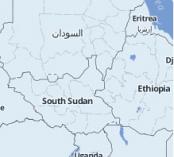
JUBA, May 19 2014 (IPS) - As with many conflicts and other humanitarian emergencies around the world, those who suffer the most are women, young girls and children. The current terrible crisis in South Sudan is no exception.
When I visited the country recently, I met women and girls, some with babies strapped on their backs, living in very poor conditions in protection camps within United Nations bases in the capital city of Juba. Walking through the camps, I also met young people, many of whom are now seeing their dreams of a better life being shattered by the violent conflict.
Many shared their stories freely with me. What is clear is that the jubilant songs sung during the country’s independence only a few years ago have now been replaced by the voices of agony and anguish of families torn apart by the violence as well as the protracted political crisis since the early 1990s.
In a report released on May, 8 the U.N. Mission in South Sudan (UNMISS) noted that the “conflict has exacerbated the vulnerability of women and children in South Sudan to sexual violence.” Sexual and gender-based violence is not new in South Sudan – but the scale has been exponential due to the conflict and the absence of protection for the most vulnerable, who are women and children. We all know that cases of gender-based violence are under-reported during times of peace, and much more so in conflict situations. Yet even one case of sexual violence is one too many.
In far flung camps, there are reports of rapists targeting women and girls as they attempt to fetch firewood, look for food or fetch water for their families. Some have been killed as a result and many are too afraid to report their violation.
Worse still, the ability of survivors of sexual violence to receive services during the precarious situation has severely diminished. Consequently, most incidents of sexual violence could not be reported to health actors, nor documented or verified through medical reports, says the UNMISS report.
And that is not all. Humanitarian crises are reproductive health disasters, especially because pregnancy-related deaths tend to soar during this period.
South Sudan has the world’s worst maternal mortality ratio of 2,054 deaths per 100,000 live births. Prior to the crisis, the country’s fertility rate was nearly seven children per woman. It is estimated that 80,000 pregnant women living in affected areas (and thus 2,800 births every month) will require care by the end of December 2014.
Furthermore, an estimated 12,000 women will likely experience complications and require care, while 4,000 births are likely to require emergency Caesarean sections. Without adequate care, this number could increase considerably.
As a result of the crisis, two thirds of the health facilities in the areas affected by the conflict are reportedly closed or operating at limited capacity. In Jonglei, Upper Nile and Unity states, the state hospitals that usually provide emergency obstetric care services are not functional. Alternative facilities at the periphery have either been looted or destroyed and/or health staff members have fled due to insecurity.
The full article continues at http://www.ipsnews.net/2014/05/op-ed-violence-leaves-women-girls-young-people-edge-south-sudan/ on Inter Press Service’s website.

